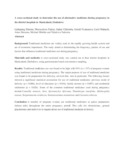Please use this identifier to cite or link to this item:
https://cris.library.msu.ac.zw//handle/11408/3779Full metadata record
| DC Field | Value | Language |
|---|---|---|
| dc.contributor.author | Dimene, Liphapang | - |
| dc.contributor.author | Mutseyekwa, Fadzai | - |
| dc.contributor.author | Chifamba, Jephat | - |
| dc.contributor.author | Nyakatawa, Gerald | - |
| dc.contributor.author | Mahachi, Carol | - |
| dc.contributor.author | Marume, Amos | - |
| dc.contributor.author | Bhebhe, Michael | - |
| dc.contributor.author | Taderera, Tafadzwa | - |
| dc.date.accessioned | 2020-07-15T09:51:36Z | - |
| dc.date.available | 2020-07-15T09:51:36Z | - |
| dc.date.issued | 2020 | - |
| dc.identifier.issn | 1680-6905 | - |
| dc.identifier.uri | https://www.ajol.info/index.php/ahs/article/view/194941 | - |
| dc.identifier.uri | : https://dx.doi.org/10.4314/ahs.v20i1.11 | - |
| dc.identifier.uri | http://hdl.handle.net/11408/3779 | - |
| dc.description.abstract | Background: Traditional medicines are widely used in the rapidly growing health system and are of economic importance. The study aimed at determining the frequency, pattern of use and factors that influence traditional medicines use during pregnancy. Materials and methods: A cross-sectional study was carried out at four district hospitals in Manicaland, Zimbabwe, using questionnaire based convenience sampling. Results: Traditional medicines use was found to be high with 54% (n = 337) of pregnant women using traditional medicines during pregnancy. The major purpose of use of traditional medicine was found to be preparation for delivery; cervical dila- tion in particular. The following factors showed a significant statistical association for use of traditional medicines: previous mode of delivery (p = 0.006), level of education (p = 0.016), family income (p = 0.007), and residential settlement (p = 0.026). Some of the common traditional medicines used during pregnancy include Camellia sinensis, Aloe, Spirostachys Africana, Thumbergia lancifolia, Dalbergiella nyasae, Steganotaenia oraliacea, Stomatostemma monteiroae and Cussonia arborea. Conclusion: A number of pregnant women use traditional medicines as partus preparators (labour aids) throughout the entire pregnancy period. This calls for obstetricians, general practitioners and midwives to inquire about use of traditional medicine in history. | en_US |
| dc.language.iso | en | en_US |
| dc.relation.ispartofseries | African Health Sciences;Vol. 20; No. 1; p.64-72 | - |
| dc.subject | Traditional medicines | en_US |
| dc.subject | Pregnancy | en_US |
| dc.subject | Zimbabwe | en_US |
| dc.title | A cross-sectional study to determine the use of alternative medicines during pregnancy in the district hospitals in Manicaland, Zimbabwe | en_US |
| dc.type | Article | en_US |
| item.fulltext | With Fulltext | - |
| item.openairetype | Article | - |
| item.languageiso639-1 | en | - |
| item.cerifentitytype | Publications | - |
| item.grantfulltext | open | - |
| item.openairecristype | http://purl.org/coar/resource_type/c_18cf | - |
| Appears in Collections: | Research Papers | |
Files in This Item:
| File | Description | Size | Format | |
|---|---|---|---|---|
| A cross.pdf | Abstract | 7.51 kB | Adobe PDF |  View/Open |
Page view(s)
10
checked on Jul 26, 2024
Download(s)
8
checked on Jul 26, 2024
Google ScholarTM
Check
Items in MSUIR are protected by copyright, with all rights reserved, unless otherwise indicated.


